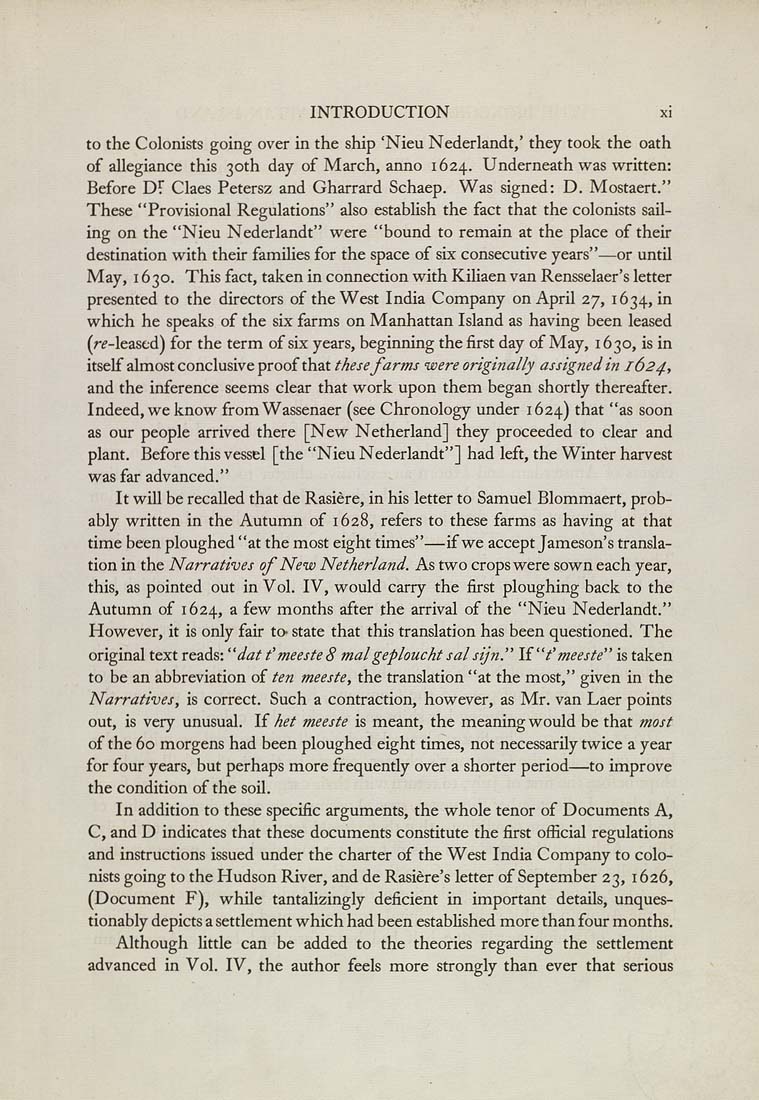INTRODUCTION xi
to the Colonists going over in the ship 'Nieu Nederlandt,' they took the oath
of allegiance this 30th day of March, anno 1624. Underneath was written:
Before Df Claes Petersz and Gharrard Schaep. Was signed: D. Mostaert."
These "Provisional Regulations" also establish the fact that the colonists sail¬
ing on the "Nieu Nederlandt" were "bound to remain at the place of their
destination with their families for the space of six consecutive years"—or until
May, 1630. This fact, taken in connection with Kiliaen van Rensselaer's letter
presented to the directors of the West India Company on April 27, 1634, in
which he speaks of the six farms on Manhattan Island as having been leased
(r^-leased) for the term of six years, beginning the first day of May, 1630, is in
itself almost conclusive proof that these farms 'were originally assigned in 1624^
and the inference seems clear that work upon them began shortly thereafter.
Indeed, we know from Wassenaer (see Chronology under 1624) that "as soon
as our people arrived there [New Netherland] they proceeded to clear and
plant. Before this vessel [the "Nieu Nederlandt"] had left, the Winter harvest
was far advanced."
It will be recalled that de Rasiere, in his letter to Samuel Blommaert, prob¬
ably written in the Autumn of 1628, refers to these farms as having at that
time been ploughed "at the most eight times"—if we accept Jameson's transla¬
tion In the Narratives of New Netherland. As two cropswere sown each year,
this, as pointed out in Vol. IV, would carry the first ploughing back to the
Autumn of 1624, a few months after the arrival of the "Nieu Nederlandt."
However, it is only fair to- state that this translation has been questioned. The
original text reads: "dat f meeste 8 malgeploucht sal sijn." l£"t'meeste" is taken
to be an abbreviation of ten meeste, the translation "at the most," given in the
Narratives, is correct. Such a contraction, however, as Mr. van Laer points
out, is very unusual. If het meeste is meant, the meaning would be that most
of the 60 morgens had been ploughed eight times, not necessarily twice a year
for four years, but perhaps more frequently over a shorter period—to improve
the condition of the soil.
In addition to these specific arguments, the whole tenor of Documents A,
C, and D indicates that these documents constitute the first official regulations
and instructions issued under the charter of the West India Company to colo¬
nists going to the Hudson River, and de Rasiere's letter of September 23, 1626,
(Document F), while tantalizingly deficient In important details, unques¬
tionably depicts a settlement which had been established more than four months.
Although Httle can be added to the theories regarding the settlement
advanced In Vol. IV, the author feels more strongly than ever that serious
|








